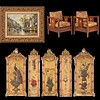6 Civil War Newspapers incl. Chattanooga Rebel plus Harper's Weekly Southern War Scenes
Bid Increments
| Price | Bid Increment |
|---|---|
| $0 | $10 |
| $100 | $25 |
| $500 | $50 |
| $1,000 | $100 |
| $3,000 | $200 |
| $5,000 | $500 |
| $10,000 | $1,000 |
| $20,000 | $2,000 |
| $50,000 | $5,000 |
| $100,000 | $10,000 |
24 items total. 1st-6th items: Six Civil War Era Southern Newspapers: The Georgia Citizen Extra, single page broadside, for July 23, 1861, reporting on the first Battle of Bull Run (in four pieces from fold line tears, taped repair at bottom); The Chattanooga Rebel for Aug. 9, 1862; the Chattanooga Daily Rebel for Aug. 9, 1862 (likely a facsimile copy); the Chattanooga Daily Rebel for May 16, 1863 (partially missing); The Chattanooga Daily Rebel for for June 21, 1863, and the Nashville Daily Bulletin for August 22, 1865. Note: "Francis M. 'Franc' Paul established the Chattanooga Daily Rebel in August 1862, then suspended publication earlier that year. Paul was principal clerk of the Tennessee senate and had formerly been a printer for Brownlow's Knoxville Whig. Paul was the Rebel's sole publisher and editor during its first few months. On a trip to Murfreesboro, he met Henry Watterson and invited him to become editor of the Rebel. Watterson already had considerable newspapering experience, having written for the press in Washington, D.C., New York, and Nashville. Shortly after Watterson began writing for the Rebel, his friend Albert Roberts joined him (Both went on to notable journalistic accomplishments after the war). As was customary amongst Civil War correspondents, both Watterson and Roberts wrote under pen names. Watterson, writing as John Burley, often criticized General Braxton Bragg's military operations, prompting Bragg to threaten to ban the paper from his camps. In addition to his war reports, Roberts provided "a cheerful witty side to every issue. His 'JOHN HAPPY' letters, 'Grapevine Telegraph' and bright, sparkling paragraphs were eagerly sought and read by the boys at the front and by the old men, women and children in the rear." The first few issues of the Rebel had four pages but it was soon reduced to a single sheet. Content included general orders for soldiers, war news via telegraph dispatches, reports from other newspapers, local matters, and ads. Towards the end of 1862, the pressing demand for the paper prompted Paul to seek out and purchase more printing equipment. With a power press purchased in Rome, Georgia, and an engine from Huntsville, Alabama, he was able to print 8,000 copies daily. 'Five thousand copies was the standing order from one army news agent, and the rest went everywhere throughout the Confederacy.' Circulation was limited by scarcity of paper rather than lack of demand." (Source: The University of Tennessee). Remaining items: 15 Civil War era Harper's Weekly Magazine pages with illustrations of mostly Southern scenes: The First Battle of Memphis, Capture of Lookout Mountain, Burning of Bowling Green KY (illustration only), Forrest's Raid into Memphis, USS Monitor Neosho on the Cumberland River & View of Nashville; Saltpeter Cave near Chattanooga, Bridge across the Holston at Knoxville, "Unionists Escaping across the Mountains of E. Tennessee," "Shelbyville the only Union Town of Tennessee", Logan's Command crossing Lookout Creek for East Tennessee and "The 20th United States Colored Troops Receiving their Colors of Union Square," Hamburg Landing, Tennessee; Interior of Fort Donelson; "A Thrilling Scene in E. Tennessee: Col. Fry and the Union Men Swearing by the Flag, " "Hospital Train from Chattanooga to Nashville," View of the city of Chattanooga. Also included are 3 later Harper's Weekly pages with scenes of Southern interest, as captioned: "Scenes in Memphis during the Riot - Burning a Freedmen's Schoolhouse" & "Shooting Down Negroes on the Morning of May 2, 1866"; "The President in the South: Viewing the Deer at Belle Meade" & "Call on Mrs. Polk at Nashville"; and "In and About Rugby: the English Colony in Tennessee".
Condition
Newspapers: All in fragile condition, with separations at fold lines, losses and tears, toning and scattered foxing. Harper's Weekly Pages: All but 2 are encapsulated (not laminated) in protective coverings and are in overall very good condition with light toning, some with scattered and minor creases and corner losses/chipping. Bowling Green illustration does not include the rest of the page.
Provenance
Estate of Gertude S. Caldwell, Nashville.
Available payment options
Payment must be received no later than five (5) days after the sale.
If paying with a credit card, a 3.5% credit card processing fee will be applied to the final sales price (i.e. hammer price + buyer's premium + applicable taxes). If you have a credit card on file with Case, any winning bids will be automatically charged (up to $3000) along with applicable fees 72 hours after you receive your invoice unless other arrangements have been made.
If paying with wire transfer, please use the following information:
Bank: Pinnacle Bank
150 Third Avenue South, Suite 900
Nashville, TN 37201
Phone # (865) 766-3000
Swift Code: PNFPUS44
Routing, Transit, ABA: 064008637
Beneficiary: Case Antiques, Inc.
4310 Papermill Drive
Knoxville, TN 37909
Account #: NOT DISCLOSED (please refer to your invoice email for the Deposit Account Number or contact us )
The UPS Store of Bearden 865-584-0081 (press 5), fax 865-584-0094 store2630@theupsstore.com Click to get a quote
The UPS Store of Northshore Knoxville Contact – Eve 865-951-2499 store6461@theupsstore.com
John & Max Express LLC NOTE: large items & white glove delivery services only (driving range limitations may apply) Contact – Dina 865-230-1568 johnmaxexpress@gmail.com






































